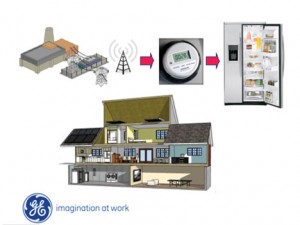What is a smart appliance, anyway?

You've heard of smart appliances, but I challenge you to tell me what they are, where you can buy them or why you'd even want them.
Fact is they are not here yet and if they were, they wouldn't do much good without the smart grid infrastructure in place. On the heels of the Dept. of Energy's (DOE) announcement yesterday that it will pump $620 million into 32 smart grid demonstration projects, I caught up with vice president of GE Energy's transmission and distribution business Bob Gilligan on the phone yesterday to discuss its deal with utility AEP Ohio which gets $75 million of those funds.

That's cool, but in advance of hyping of those projects before they happen, I steered the conversation to smart appliances because it's my sense consumers have heard of them, but know little about them. The idea is quite simple: smart appliances operate when electricity is cheapest and most abundant.
"All a smart appliance does is respond to a pricing signal and decide when it's most economical [to operate]." says Gilligan. "It's not whiz bang technology." Obviously, they are appliances that typically consume the most electricity: heating/AC, water heater, cooktop, oven, dryer, dishwasher and refriegerator. "Those are the biggies."
A good example of an early smart appliance is GE's heat pump hybrid water heater which I wrote about a while ago back in describing the the company's vision for a zero energy home by 2015.
But before smart appliances can dent your electric bill and make you a more efficient consumer, the smart grid has to be built out which is beginning to happen through yesterday's announcement and generous government funding.
"For [smart appliances] to work, you need a smart grid, sensors and communications [as well as] smarter policy for the utility to care about efficiency and smart pricing," says Gilligan. The first step is deployment of smart meters which act as the mid communication point between the utility and the appliance. The utility constantly broadcasts rates and electricity demand to the smart meter. That meter feeds that information to the appliance which delays operation if possible (difficult for cooking) until off-peak rates or goes into an economy mode.
The idea is analogous to how we used to defer making long distance calls when rates were cheaper at night or on weekends. With unlimited long distance and cell phones plans, we don't do that much anymore, but the principle for those old enough to remember is the same with smart appliances.
So the biggest hurdle initially will be educating consumers why efficiency is important and what they can do about it. "If you understand what a kilowatt hour is, you are in the one percent [of consumers]. We're working with consumers on how they would like to see information and different kinds of displays."
In other words, the benefits of smart appliances will have to be easy to understand and implement. That's the challenge. He expects we'll start seeing smart appliances in a couple of years following infrastructure improvements and major smart meter deployments.
Gilligan says consumers may initially get religion on the smart grid through the biggest and smartest appliance of all -- the plug-in electric car. "Our existing infrastructure will allow us to have 75 per cent of our cars and light trucks be electric, [if] we charge after 8 p.m.," he says. The speed of electric car adoption depends on a host of factors - gas prices and vehicle cost, performance and reliability among them -- and will be uneven across the nation.
They say necessity is the mother of invention. When it comes to energy, necessity will make us smarter, too. That's why I have said $20 a gallon gasoline is not an entirely bad thing.
Follow me on Twitter.
This post was originally published on Smartplanet.com